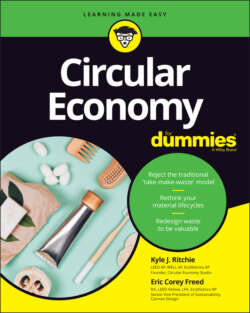Читать книгу Circular Economy For Dummies - Eric Corey Freed - Страница 45
We’re Making the Wrong Stuff
ОглавлениеThe linear economic model of take-make-waste isn’t flawed only in the resources we’re taking; what we’re making is also out of step with reality.
Every year, humans produce 300 tons of new plastic, most of which ends up in landfills or oceans. If you look around your home, you quickly discover how many items are made of plastic. If you take a peek into your trash and recycling bins, you might also notice how much of that is plastic as well.
Companies use plastic because it’s durable, flexible, colorful, and washable, but more importantly, because it’s cheap. The raw materials for plastic are easily available, and you can mold it into any shape you want. That’s why we humans use so much of it.
Relying on plastic for so much of what’s produced isn’t the only issue with the stuff we make. There are several common problems with all the stuff we produce:
Poor materials: The product uses cheap materials that pollute during the production process.
Lack of durability: The products are designed to break, forcing customers to buy new ones after a short time.
Energy intensive: The products require massive amounts of energy to produce, which results in the release of carbon emissions.
Produces waste: Every ton that’s produced creates many times that amount of waste.
Doesn’t reflect the product's true cost: The cost to operate or maintain the product is paid later on by the consumer.
Doesn’t reflect the product's true impact: The damage to the environment isn’t paid for or cleaned up by anyone.
Not upgradable: The product can’t be upgraded after parts are outdated.
Not repairable: The product isn’t designed to be repaired.
Not recyclable: The product mixes materials that makes recycling them difficult or impossible.
Doesn’t disassemble: The product cannot be taken apart to make recycling or repair easier.
Not as useful as possible: The product has a single, limited, or short-term use that isn’t as useful as it could be.
Not local: The product is produced from materials sourced from faraway or that must be shipped long distances to reach the hands of customers.
Most of the products people buy feature some (or even all) of these shortcomings. These issues only perpetuate the linear economic model. What’s needed is a rethinking and redesign of all our materials and products to fix these problems and allow us to bend those linear pathways to become circular.
